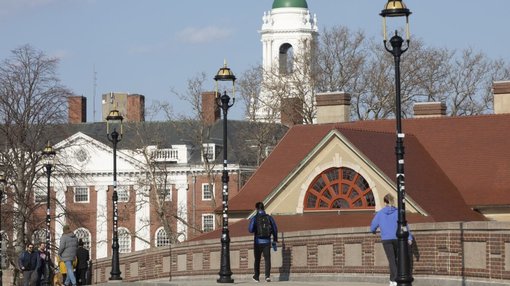Horrors! Davidson Professors Book Explores Music in Scary Movies
Archive by Erudera News Jun 17, 2010

by John Syme
The sound of fear is the sound of music for Associate Professor of Music Neil Lerner. His book Music in the Horror Film: Listening to Fear has been released by Routledge. Lerner is editor of the book, and wrote one of its 12 chapters. The book is the first in Routledge’s “Music and Screen Media” series, for which Lerner is the series editor. The series will have edited collections designed to interest academic and lay audiences across music and media studies.
Lerner, a musicologist, specializes in the study of music in the cinema. He has long been drawn to the horror genre, since his undergraduate student days at (drum roll, please) Transylvania University in Lexington, Ky., where he first started thinking seriously about vampires. His doctoral dissertation at Duke University was one of the first nationally to explore music in film. He has been researching horror through his work on the film The Beast with Five Fingers (published in Sounding Off, another book he did with Routledge) and for several papers about music in the cult television series Buffy the Vampire Slayer.
Earlier this month, he gave a talk at the fourth annual Slayage Conference of the Whedonverses, at Flagler College in St. Augustine, Fla., titled “A Musical Alpha to Omega: Comparing Musical Languages between the First and Final 150 Seconds of Buffy the Vampire Slayer.” (Knowledgeable campus sources report that Lerner is regarded as a “rock star” among Buffy fans—maybe in part because he regularly provides the piano music for the traditional singalong of Buffy’s musical episode.)
So why horror? Call it a gut feeling.
“Horror film’s repetitious drones, clashing dissonances, and stingers (those assaultive blasts that coincide with shock or revelation) affect us at a primal level, perhaps instinctually taking us back to a much earlier time when the ability to perceive a variety of sounds alerted us (as a species) to approaching predators or other threats,” Lerner writes in the preface to Listening to Fear.
He also avers his attraction to horror films as a film genre that has been time-tested as “one of the most disreputable and profitable.”
Academically, Lerner says that the evolution of musical soundtracks in horror films is a logical extension of music’s broader history.
The story of Western music gets complicated as it gets into the 20th century, where some composers began to write increasingly complicated and alienating works, Lerner said.
“I noticed early in my teaching career that pieces by Stravinsky, Schoenberg, and Webern, some of the major composers of the early 20th century, drew troubled looks from students when they heard them in the stark isolation of a classroom, staring at a speaker or a score,” he said. “Those same musical gestures, though, made much more sense to students when they encountered them in the context of a scary movie. I recognized long ago that studying musical styles, even particularly difficult ones, shouldn’t end with the concert hall and opera stage, but should extend into the study of mass media, where musicologists have much to add to the scholarly conversation.”
For proof of the enduring visceral power of music in horror, Lerner need look, or listen, no further than his students. At the beginning of his courses on film music, he plays a selection of unaccompanied audio clips, out of the context of the movies and TV shows in which they appeared. Time and again, students’ interpretations are uncannily accurate.
“Whatever’s happening in that music, it’s still communicating. They nail it. If you grew up watching TV and movies and videogames, you know what this music means, even if you don’t know how it means,” he said. “It’s almost creepy to me sometimes how detailed students can get in their descriptions of what’s going on onscreen with the music. Teaching students how to sift through and understand these musical codes helps them to become more sophisticated readers of screen media.”
Lerner knows from creepy, and uncanny. The chapter he wrote for Music in the Horror Film: Listening to Fear is “The Strange Case of Rouben Mamoulian’s Sound Stew: The Uncanny Soundtrack in Dr. Jekyll and Mr. Hyde (1931).” Lerner writes of the director and his work: “With Mamoulian’s version of Dr. Jekyll and Mr. Hyde, sound design and music took on an enhanced role in the film’s creation of dread and revulsion for the audience.” His archival research, supported by the college, took him to Hollywood and the Library of Congress, where Lerner studied production papers and director Mamoulian’s materials.
Listening to Fear contains two other essays with Davidson connections, chapters by former Lerner students Ross J. Fenimore ’02 (“Voices That Lie Within: The Heard and the Unheard in Psycho”) and Claire Sisco King ’99 (“Ramblin’ Men and Piano Men: Crises of Music and Masculinity in The Exorcist.”). King currently teaches in the Communication Studies department at Vanderbilt University, while Fenimore is writing a musicology dissertation at UCLA.
“Both Ross and Claire were thorough researchers and interesting, thoughtful writers when they were Davidson students, and their skills have only improved as they’ve pursued their own academic paths,” said Lerner.
Lerner has been at Davidson since 1997, teaching courses in the music department, in Humanities, and for the Concentration in Film & Media Studies. Besides regularly offering courses on film music, Lerner has also developed a course on video games (“Interactive Digital Narratives”) for the Concentration in Film & Media Studies, and he offers upper-level seminars on musical topics like Aaron Copland, music and gender, and the collaboration between Alfred Hitchcock and Bernard Herrmann. Since 2006 he has worked with Frank Dominguez and WDAV to create the radio series “Reel Music.” Recently elected Secretary of the Society for American Music, Lerner is also beginning a three-year stint as editor of the journal American Music.
Davidson is a highly selective independent liberal arts college for 1,800 students located 20 minutes north of Charlotte in Davidson, N.C. Since its establishment in 1837 by Presbyterians, the college has graduated 23 Rhodes Scholars and is consistently regarded as one of the top liberal arts colleges in the country. Through The Davidson Trust, the college became the first liberal arts institution in the nation to replace loans with grants in all financial aid packages, giving all students the opportunity to graduate debt-free. Davidson competes in NCAA athletics at the Division I level, and a longstanding Honor Code is central to student life at the college.
Recent Articles
United Kingdom
Apr 24, 2024
Germany
Apr 24, 2024
United States
Apr 23, 2024
Canada
Apr 23, 2024
United States
Apr 22, 2024


